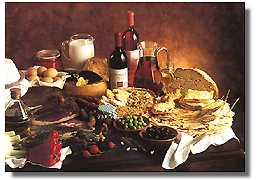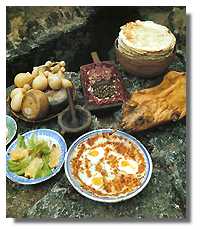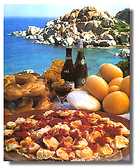
Sardinian food
Visiting Cagliari means discovering a rich and varied style of cooking. We suggest
ignoring, at least for once, the numerous (and excellent) Italian and international
restaurants and to be tempted by the traditional flavors of Sardinian cooking.
The choice begins with bread. Some examples are: su civraxu, the most common, large,
round, flour loaf; su coccoi
made with hard-wheat semolina and cut on top with scissors to form small decorative
points (is pizzicorrus) that become crisp and golden when baked; su pani carasau
or carta musica (literally, sheet music) a round, wafer thin, crisp sheet of flour
and semolina. Excellent served with salt and olive oil, it is then called su pani guttiau.
Pani carasau is used to make a homely but delicious first course, su pani frattau,
in which the thin sheets are first dipped in broth or boiling salted water, layered
with tomato sauce, minced meat and grated cheese, and topped with a poached egg.
Another flat bread is the soft, round spianadas.

A Sardinian meal always begins with an appetizer: wild boar ham, sausage lamb or veal
trotters, clams or mussels cooked alla marinara with white wine, garlic, and parsley,
burrida (dogfish marinated in a walnut and garlic sauce), bottariga
(salted, dried and pressed roe of tuna or mullet) served in paper thin slices with lemon and olive oil.
First courses include: sa fregula, an irregularly shaped, grain sized pasta served in fish
broth; malloreddus a small grooved pasta flavored with saffron and served with tomato sauce and cheese;
culingionis, ravioli made with semolina (often with a potato puree and mint filling); and panadas,
a round cylindrical pie filled with vegetables, meat or eels. Panadas is such a
popular specialty that there is a yearly festival dedicated to it in Assemini in
July.
The traditional Sardinian meats are spit-roasted suckling pig, baby lamb, and kid.
The more adventurous might want to try sa cordula, cleaned lamb intestines sauté
ed with peas, or knotted into an intricate braid with
variety meats and oven or spit roasted. Another specialty is sanguinaccio, a pork-blood
sausage sweetened with raisins and sugar, served boiled or roasted.
|









